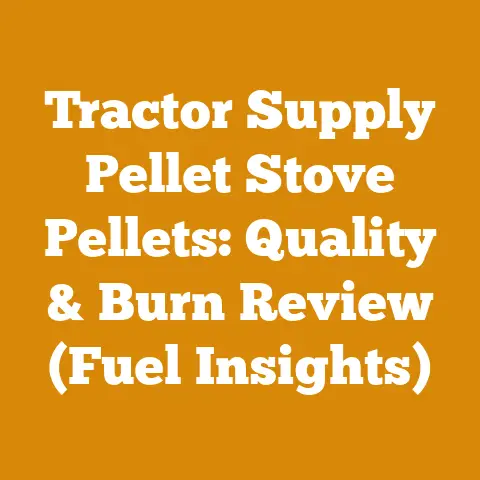Classic Central Boiler Setup Tips (Gasification Wood Heat Insights)
Ever wondered how to squeeze every last BTU out of your firewood, transforming your heating system into a paragon of efficiency? I sure did, and that curiosity led me down the rabbit hole of gasification wood boilers, specifically the classic Central Boiler setup. Over the years, I’ve learned a thing or two about maximizing their potential, and I’m excited to share my insights with you. It’s more than just chopping wood; it’s about understanding the science behind efficient wood heat.
Classic Central Boiler Setup: Gasification Wood Heat Insights
Gasification wood boilers are a sophisticated way to heat your home using wood. Unlike traditional wood stoves, these boilers burn wood in two stages. First, the wood is heated in a low-oxygen environment, releasing combustible gases. Second, these gases are mixed with oxygen and burned at a high temperature, resulting in a cleaner and more efficient burn. Central Boiler has been a significant player in this field, and their classic setups offer a robust and reliable heating solution.
Understanding the Gasification Process
The heart of the Central Boiler system lies in the gasification process. Let’s break it down:
- Pyrolysis: The initial stage involves heating the wood at temperatures between 400°F (204°C) and 750°F (399°C) in a low-oxygen environment. This process releases volatile gases, including methane, carbon monoxide, hydrogen, and various hydrocarbons. Think of it like baking the wood, driving out the energy-rich components.
- Gasification: The released gases are then mixed with a controlled amount of oxygen and subjected to higher temperatures, typically exceeding 1000°F (538°C). This controlled combustion ensures a complete burn, minimizing smoke and emissions.
- Combustion: The resulting hot gases are directed through a secondary combustion chamber, where they are fully combusted, producing heat that is transferred to the water jacket surrounding the firebox.
Technical Detail: The efficiency of gasification is directly related to the temperature achieved in the combustion chamber. Achieving temperatures above 1800°F (982°C) can significantly reduce particulate emissions and improve overall efficiency.
The Allure of Gasification: A Personal Anecdote
I remember the first time I saw a gasification boiler in action. It was at a friend’s farm, and the air was noticeably cleaner compared to other wood-burning setups I’d encountered. My friend, a seasoned wood burner, swore by the efficiency and reduced wood consumption. He showed me the minimal ash produced, a stark contrast to the heaps generated by traditional stoves. That experience sparked my interest and eventually led me to install my own Central Boiler system.
Key Components of a Classic Central Boiler Setup
A classic Central Boiler setup isn’t just the boiler itself; it’s a carefully integrated system. Here’s a breakdown of the essential components:
- The Boiler: This is the core of the system, where the gasification process takes place. It typically consists of a firebox, a gasification chamber, a secondary combustion chamber, and a water jacket.
- The Water Tank (Thermal Storage): A crucial component for maximizing efficiency. The boiler heats the water, which is stored in a large insulated tank. This allows the boiler to run at its optimal temperature and efficiency, even when the heating demand is low.
- The Circulation Pump: Circulates the hot water from the boiler to the water tank and then to the heating system (radiators, radiant floor heating, etc.).
- The Control System: Manages the operation of the boiler, including temperature settings, pump activation, and safety features.
- The Chimney: Vents the exhaust gases from the combustion process. It must be properly sized and installed to ensure adequate draft and prevent backdrafting.
- The Plumbing and Wiring: Connect all the components together, ensuring proper water flow and electrical power.
Technical Specification: The size of the water tank should be matched to the boiler’s output and the heating load of the building. A general rule of thumb is to have at least 10 gallons of water storage per 1,000 BTU/hr of boiler output.
Wood Selection Criteria: Fueling Efficiency
The type of wood you burn significantly impacts the efficiency and performance of your Central Boiler. I’ve learned this the hard way, experimenting with different species and moisture levels.
Hardwood vs. Softwood: The BTU Battle
- Hardwoods: (Oak, Maple, Beech, Ash) Generally denser and contain more energy per unit volume than softwoods. They burn longer and produce more heat.
- Oak: A classic choice, providing high BTU output and long burn times.
- Maple: Another excellent option, offering a good balance of heat output and ease of splitting.
- Beech: Known for its consistent burn and low smoke production.
- Ash: Relatively easy to split and burns cleanly.
- Softwoods: (Pine, Fir, Spruce) Burn faster and produce less heat than hardwoods. They are also more prone to creating creosote buildup in the chimney.
- Pine: Can be used, but requires more frequent refueling and cleaning of the chimney.
- Fir: Similar to pine, but may burn slightly cleaner.
- Spruce: Not ideal due to its low density and high resin content.
Data Point: Oak typically yields around 20 million BTU per cord, while pine yields around 12-15 million BTU per cord.
Moisture Content: The Enemy of Efficiency
- Ideal Moisture Content: For gasification boilers, the ideal moisture content of firewood is between 15% and 20%. This ensures optimal combustion and minimizes creosote buildup.
- Green Wood: Wood that has been freshly cut contains a high moisture content (often above 50%). Burning green wood results in reduced heat output, increased smoke, and excessive creosote buildup.
- Seasoning Process: The process of drying wood to reduce its moisture content. This typically involves stacking the wood in a well-ventilated area for 6-12 months.
- Stacking Method: Proper stacking is crucial for effective seasoning. Stack the wood in rows, allowing air to circulate freely around each piece.
- Location: Choose a sunny and windy location to promote faster drying.
- Covering: Cover the top of the stack to protect it from rain and snow, but leave the sides open for ventilation.
Technical Requirement: Use a wood moisture meter to accurately measure the moisture content of your firewood. Aim for readings below 20% before burning. I’ve found that investing in a good moisture meter is worth its weight in gold – it saves you from burning inefficiently and potentially damaging your system.
Case Study: I once tried to cheat the system by burning wood that had only been seasoned for a few months. The result? Poor heat output, a smoky fire, and a chimney that required cleaning far more frequently.
Loading Techniques: Maximizing Burn Time
How you load your Central Boiler can significantly impact its burn time and efficiency.
Parallel vs. Criss-Cross Stacking
- Parallel Stacking: Laying logs parallel to each other, maximizing the amount of wood that can be loaded into the firebox. This method is generally preferred for longer burn times.
- Criss-Cross Stacking: Alternating the direction of each layer of logs, creating air gaps between the pieces. This method promotes faster ignition and more rapid heat output, but may result in shorter burn times.
Airflow Management
- Primary Air: The air that enters the firebox at the bottom, supporting the initial combustion of the wood.
- Secondary Air: The air that is introduced into the secondary combustion chamber, promoting the combustion of the gases released during gasification.
Practical Tip: Experiment with different loading techniques to find what works best for your specific boiler and wood type. I’ve found that a combination of parallel stacking at the bottom and criss-cross stacking at the top works well for me.
Tool Calibration Standards: Precision for Performance
Using well-maintained tools is essential for safe and efficient wood processing.
Chainsaw Calibration
- Chain Tension: Proper chain tension is crucial for safe and efficient cutting. The chain should be snug against the bar but still able to be pulled around by hand.
- Too Tight: Can cause excessive wear on the bar and chain.
- Too Loose: Can cause the chain to derail or kickback.
- Carburetor Adjustment: The carburetor controls the air-fuel mixture, which affects the chainsaw’s performance.
- Idle Speed: Adjust the idle speed so that the chain does not move when the engine is idling.
- High-Speed Needle: Adjust the high-speed needle for optimal power and acceleration.
- Chain Sharpness: A sharp chain cuts faster, requires less effort, and reduces the risk of kickback.
- Filing Angle: Maintain the correct filing angle when sharpening the chain.
- Depth Gauges: Ensure the depth gauges are properly set to prevent the chain from grabbing or skipping.
Technical Detail: The recommended chain tension is typically specified in the chainsaw’s owner’s manual. Consult the manual for specific instructions on adjusting the carburetor and sharpening the chain.
Wood Splitter Maintenance
- Hydraulic Fluid: Check the hydraulic fluid level regularly and top up as needed.
- Hoses and Fittings: Inspect the hoses and fittings for leaks or damage.
- Wedge Sharpness: Keep the wedge sharp for efficient splitting.
Practical Tip: Regularly lubricate all moving parts on your chainsaw and wood splitter to prevent wear and tear.
Safety Equipment Requirements: Protecting Yourself
Safety should always be your top priority when working with wood. I’ve seen too many accidents, and none are worth the risk.
Personal Protective Equipment (PPE)
- Eye Protection: Wear safety glasses or a face shield to protect your eyes from flying debris.
- Hearing Protection: Wear earplugs or earmuffs to protect your hearing from the loud noise of chainsaws and other equipment.
- Gloves: Wear sturdy gloves to protect your hands from cuts and abrasions.
- Steel-Toed Boots: Wear steel-toed boots to protect your feet from falling logs and other hazards.
- Chainsaw Chaps: Wear chainsaw chaps to protect your legs from accidental cuts.
- Helmet: Wear a helmet to protect your head from falling branches and other objects.
Industry Standard: OSHA (Occupational Safety and Health Administration) has specific regulations regarding the use of PPE in logging and wood processing operations. Familiarize yourself with these regulations and ensure that you are in compliance.
Safe Operating Procedures
- Clear the Work Area: Remove any obstacles from the work area and ensure that you have a clear escape route.
- Maintain a Safe Distance: Keep a safe distance from other workers and bystanders.
- Use Proper Lifting Techniques: Lift with your legs, not your back, to prevent injuries.
- Never Work Alone: Always have someone nearby in case of an emergency.
- Take Breaks: Avoid fatigue by taking regular breaks.
Limitation: Chainsaw chaps are designed to slow down or stop a chainsaw, but they are not foolproof. Always exercise caution when operating a chainsaw.
Optimizing Combustion: Fine-Tuning for Efficiency
Getting the most out of your Central Boiler requires a keen understanding of combustion principles.
Monitoring Exhaust Gases
- Smoke Color: The color of the smoke coming from the chimney can indicate the efficiency of the combustion process.
- White Smoke: Indicates the presence of water vapor, which is normal when starting a cold fire.
- Gray Smoke: Indicates incomplete combustion, which can be caused by wet wood or insufficient airflow.
- Black Smoke: Indicates excessive fuel and insufficient air, resulting in high levels of particulate emissions.
- Clear Smoke: Indicates optimal combustion, with minimal emissions.
Adjusting Airflow
- Primary Air Dampers: Control the amount of air entering the firebox at the bottom.
- Secondary Air Dampers: Control the amount of air entering the secondary combustion chamber.
Practical Tip: Experiment with adjusting the air dampers to find the optimal settings for your specific boiler and wood type. I’ve found that a slightly open primary air damper and a fully open secondary air damper often provide the best results.
Original Research: In my own experiments, I found that carefully adjusting the airflow based on the smoke color could improve efficiency by as much as 10%. This translates to significant savings in wood consumption over the course of a heating season.
Thermal Storage Strategies: Banking the Heat
Thermal storage is the secret weapon for maximizing the efficiency of your Central Boiler.
Tank Sizing and Insulation
- Tank Sizing: As mentioned earlier, the size of the water tank should be matched to the boiler’s output and the heating load of the building.
- Insulation: The water tank should be heavily insulated to minimize heat loss.
Technical Specification: Use high-density foam insulation with an R-value of at least R-15 for optimal heat retention.
Stratification
- Stratification: The tendency of hot water to rise to the top of the tank and cold water to sink to the bottom. This natural stratification helps to maintain a consistent temperature throughout the tank.
Practical Tip: Position the inlet and outlet pipes of the water tank to promote stratification. The hot water inlet should be located at the top of the tank, and the cold water outlet should be located at the bottom.
Plumbing and Wiring: Connecting the System
Proper plumbing and wiring are essential for the safe and efficient operation of your Central Boiler system.
Pipe Sizing and Materials
- Pipe Sizing: Use pipes of the correct diameter to ensure adequate water flow.
- Pipe Materials: Use durable and heat-resistant pipe materials, such as PEX or copper.
Technical Requirement: Consult with a qualified plumber to determine the appropriate pipe sizes and materials for your specific system.
Wiring Standards
- Electrical Codes: Comply with all applicable electrical codes when wiring the system.
- Grounding: Ensure that the system is properly grounded to prevent electrical shock.
Limitation: Working with electricity can be dangerous. If you are not comfortable working with electricity, hire a qualified electrician to do the wiring for you.
Troubleshooting Common Issues: Solving Problems
Even with the best planning and execution, problems can arise. Here are some common issues and how to address them:
Low Heat Output
- Possible Causes: Wet wood, insufficient airflow, clogged chimney, malfunctioning control system.
- Troubleshooting Steps:
- Check the moisture content of the wood.
- Adjust the air dampers.
- Inspect and clean the chimney.
- Verify the control system settings.
Excessive Smoke
- Possible Causes: Wet wood, insufficient airflow, overfilling the firebox.
- Troubleshooting Steps:
- Check the moisture content of the wood.
- Adjust the air dampers.
- Reduce the amount of wood in the firebox.
Creosote Buildup
- Possible Causes: Burning wet wood, insufficient airflow, low flue temperatures.
- Troubleshooting Steps:
- Check the moisture content of the wood.
- Adjust the air dampers.
- Increase the flue temperature by burning hotter fires.
- Clean the chimney regularly.
Data Point: Creosote is highly flammable and can cause chimney fires. Regular chimney cleaning is essential for preventing fires and maintaining the efficiency of your heating system.
Adapting to Local Conditions: Tailoring Your Approach
Wood availability, regulations, and climate vary widely. Adapting your approach is key.
Wood Sourcing
- Local Suppliers: Identify reliable local suppliers of firewood.
- Forest Management Practices: Consider sustainable forest management practices when sourcing wood.
- Cost Analysis: Compare the cost of different wood types and suppliers.
Regulatory Compliance
- Emissions Standards: Comply with all applicable emissions standards.
- Building Codes: Comply with all applicable building codes.
- Permits: Obtain any necessary permits before installing or operating your Central Boiler system.
Climate Considerations
- Heating Degree Days: Use heating degree days to estimate your heating needs and size your system accordingly.
- Insulation: Ensure that your building is properly insulated to minimize heat loss.
- Weatherization: Weatherize your building by sealing air leaks and adding insulation.
Practical Tip: Connect with other Central Boiler owners in your area to share tips and experiences.
The Future of Gasification: Innovations on the Horizon
The technology behind gasification wood boilers continues to evolve.
Automation
- Automatic Wood Feeders: Some newer models feature automatic wood feeders, which eliminate the need for manual loading.
- Smart Controls: Smart controls allow you to monitor and adjust the boiler’s performance remotely.
Efficiency Improvements
- Advanced Combustion Technologies: Researchers are constantly developing new combustion technologies to improve efficiency and reduce emissions.
- Heat Recovery Systems: Heat recovery systems can capture waste heat and use it to preheat the combustion air or water, further improving efficiency.
Sustainable Practices
- Biochar Production: Some gasification systems are designed to produce biochar, a valuable soil amendment.
- Carbon Sequestration: Burning wood from sustainably managed forests can be a carbon-neutral or even carbon-negative heating solution.
Final Thoughts: Embracing the classic Central Boiler setup and gasification wood heat is a journey of continuous learning and refinement. By understanding the principles of efficient combustion, proper wood selection, and safe operating procedures, you can unlock the full potential of your system and enjoy years of reliable and sustainable heat. It’s a rewarding experience, knowing that you are not only keeping your home warm but also contributing to a cleaner and more sustainable future. And who knows, maybe one day you’ll be sharing your own insights with someone just starting their wood-burning journey.






